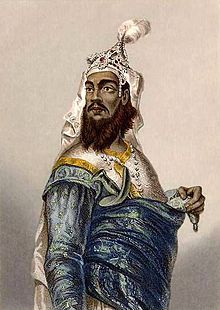Kunwar Singh: Difference between revisions
No edit summary Tags: Mobile edit Mobile web edit |
No edit summary Tags: Mobile edit Mobile web edit |
||
| Line 10: | Line 10: | ||
|successor1 = Amar Singh II |
|successor1 = Amar Singh II |
||
|predecessor1 = Shabzada Singh |
|predecessor1 = Shabzada Singh |
||
|house = [[Ujjainiya]] |
|house = [[Ujjainiya]] [[Parmar]] [[Rajput]] |
||
|birth_date = 1777 |
|birth_date = 1777 |
||
|death_date = {{death date and age|1858|04|26|1777|}} |
|death_date = {{death date and age|1858|04|26|1777|}} |
||
Revision as of 12:13, 2 October 2017
This article needs additional citations for verification. (April 2015) |
| Kunwar Singh | |
|---|---|
 Kunwar Singh, a steel engraving from 'The Indian Empire', c.1858, with modern hand coloring | |
| Maharaja of Jagdispur | |
| Predecessor | Shabzada Singh |
| Successor | Amar Singh II |
| Born | Kunwar Singh 1777 Jagdispur, Bihar |
| Died | April 26, 1858 (aged 80–81) Jagdispur, Bihar |
| House | Ujjainiya Parmar Rajput |
| Father | Raja Shabzada Singh |
| Mother | Rani Panchratan Kunwari Devi Singh |
Maharaja Babu Veer Kunwar Singh (1777 – 26 April 1858) belonged to a royal Ujjainiya Rajput house of Jagdispur, currently a part of Bhojpur district, Bihar, India. At the age of 80 years, during India's First War of Independence in 1857, he led a select band of armed soldiers against the troops under the command of the British East India Company. He was the chief organizer of the fight against the British in Bihar.
Early life
Kunwar Singh was born in November 1777 to Maharaja Shahabzada Singh and Mahrani Panchratan Devi, in Jagdispur of the Shahabad (now Bhojpur) District, in the state of Bihar. He belonged to the Ujjainiya Rajput clan which is a branch of the Parmars.[1] He married the daughter of Raja Fateh Naraiyan Singh (a Mewari Sisodiya Rajput), a wealthy zamindar of Gaya district, Bihar, and a descendant of Maharana Pratap of Mewar.
Role in the 1857 rebellion

Singh led the Indian Rebellion of 1857 in Bihar. He was nearly eighty and in failing health when he was called upon to take up arms. He gave a good fight and harried British forces for nearly a year and remained invincible until the end. He was an expert in the art of guerilla warfare. His tactics left the British puzzled.[2]
Singh assumed command of the soldiers who had revolted at Danapur on 25 July. Two days later he occupied Arrah, the district headquarters. Major Vincent Eyre relieved the town on 3 August, defeated Singh's force and destroyed Jagdishpur. During the rebellion, his army had to cross the Ganges river. Douglas' army began to shoot at their boat. One of the bullets shattered Singh's left wrist. Singh felt that his hand had become useless and that there was the additional risk of infection due to the bullet-shot. He drew his sword and cut off his left hand near the elbow and offered it to the Ganges.[2][3]
Singh left his ancestral village and reached Lucknow in December 1857. In March 1858 he occupied Azamgarh.[citation needed] However, he had to leave the place soon. Pursued by Brigadier Douglas,[who?] he retreated towards his home in Ara, Bihar. On 23 April, Singh had a victory near Jagdispur over the force led by Captain le Grand (le gard in Hindi). On 26 April 1858 he died in his village. The mantle of the old chief now fell on his brother Amar Singh II who, despite heavy odds, continued the struggle and for a considerable time, running a parallel government in the district of Shahabad. In October 1859, Amar Singh II joined the rebel leaders in the Nepal Terai.[3]
Death
In his last battle, fought on 23 April 1858, near Jagdispur, the troops under the control of the East India Company were completely routed. On 22 and 23 April being injured he fought bravely against the British Army and with the help of his army drove away the British Army, brought down the Union Jack from Jagdishpur Fort and hoisted his flag.[citation needed] He returned to his palace on 23 April 1858 and soon died on 26 April 1858.[2][4]
Legacy
To honour his memory and his contribution to India’s freedom movement, the Republic of India issued a commemorative stamp[5] on 23 April 1966. Named after him, Government of Bihar established Veer Kunwar Singh University, Arrah in 1992.[6]
The ICSE board has in its Hindi textbook (Ekanki Suman) a play by Jagdish Chandra Mathur (by the name of Vijay Ki Vela, literally: Moment of Victory and Veer Kunwar Singh) on the later part of Veer Kunwar Singh's life, starting from the time he was crossing the river Ganges and finishing with his death, because of his injury. He is mentioned as a revolutionary in the poem "Jhansi Ki Rani" by Subhadra Kumari Chauhan.
"Is Swatantrata Mahayagna mein kayee veervar aaye kaam, Nana dhundhupant , Tantya, Cchatur Azeemullah sarnam,
Ahmedshah Moulvi, Thakur Kunwar Singh, Sainik Abhiram, Bharat key itihaas gagan mein amar rahengey jinkey naam."
Jhansi Ki Rani (With English Translation) by Subhadra Kumari Chauhan[7]
See also
References
- ^ https://books.google.co.uk/books?id=65vrBAAAQBAJ&pg=PT91&dq=kunwar+singh+1857&hl=en&sa=X&ved=0ahUKEwjYxNfyvrLQAhVpIMAKHR_5DBwQ6AEIJDAC#v=onepage&q=kunwar%20singh%201857&f=false
- ^ a b c Sarala, Śrīkr̥shṇa (1999). Indian Revolutionaries: A Comprehensive Study, 1957-1961, Volume 1. Bihar: Prabhat Prakashan. p. 73. ISBN 978-81-87100-16-4.
- ^ a b History of Bhojpur Archived 14 June 2012 at the Wayback Machine. Bhojpur.bih.nic.in. Retrieved on 2011-10-12.
- ^ 1857 – A Story on Stamps. Indiapicks.com. Retrieved on 2011-10-12.
- ^ Stemp at Indiapost. Indianpost.com (1966-04-23). Retrieved on 2011-10-12.
- ^ Veer Kunwar Singh University. Vksu-ara.org (1992-10-22). Retrieved on 2011-10-12.
- ^ http://allpoetry.com/poem/8586979-Jhansi_Ki_Rani__With_English_Translation_-by-Subhadra_Kumari_Chauhan
